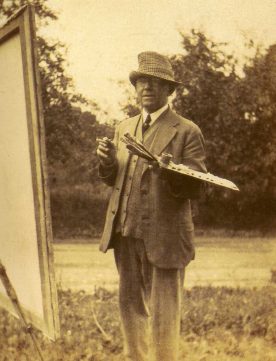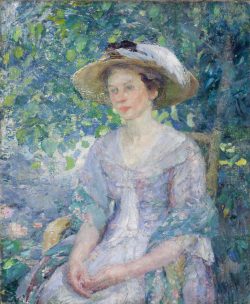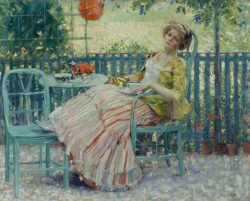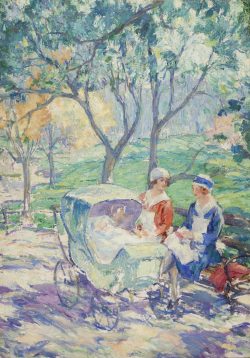Karl Buehr painting, from an undated photograph, courtesy Richard Norton Gallery, Chicago.

Karl Buehr 1866–1952
A native of Germany, Karl Albert Buehr arrived in Chicago as a youth and began working for a commercial lithographer before enrolling in the fledgling Art Institute of Chicago in 1888. He graduated with honors in 1894 but continued studying at the school intermittently until 1897 when, already assisting as a teacher, he was cited as one of its most accomplished pupils. Following service in the Spanish-American War in 1898, Buehr married Mary Hess, a painter of floral works and portrait miniatures. The couple traveled to England, where Buehr studied briefly with American expatriate artist Frank Duveneck. In Paris, he enrolled in the Académie Julian, winning a gold medal in a student exhibition. Buehr traveled in rural Holland, visited Venice, and studied in Rome. In 1905, the Buehrs returned to London, where Karl worked under celebrated English artist and designer Frank Brangwyn.
The Buehrs were back in France in 1908, soon joining the American expatriate colony of impressionist painters in Giverny, famed as the home of Claude Monet. Buehr’s associates there included Louis Ritman and Lawton Parker, from whom he rented a neighboring house, as well as Frederick Frieseke and Richard Emil Miller. All were drawn to themes of women at leisure posed in gardens or sun-filled interiors, and to the rich textures, patterned decorative effects, and pastel colors of a conservative impressionism favored by American critics and buyers. In this setting Buehr developed a personal style and subject type that he would continue to use long after his return home at the outbreak of World War I.
Appointed to the faculty of the Art Institute in 1914, Buehr was a beloved teacher there for a quarter-century. In the late 1920s, he also taught at Stanford University and at the University of California at Berkeley. He was equally successful as an exhibiting painter, winning numerous awards and, in 1922, election as an associate member of the venerable National Academy of Design in New York. Buehr painted commissioned portraits and also made etchings, but he is best known for his paintings of pretty young women in pastoral outdoor settings; many of these were modeled on his daughter Kathleen who, like his son, George, also became an artist. The Buehrs often summered in Wyoming, New York, the rolling hills of which appear as backgrounds in his figural paintings, and he made pure landscapes based on his travels to Vermont and to Taos, New Mexico. “The mention of his name spells sunshine on a summer day, clear, lovely women who smile from a fresh canvas, and a quantity of flowers,” wrote Chicago Tribune art critic Eleanor Jewett at his death: “Storm and shadow were foreign to him.”i
Wendy Greenhouse, PhD
i Eleanor Jewett, “U. of C. Offers Series of 12 Art Lectures,” Chicago Tribune, Oct. 19, 1952.


